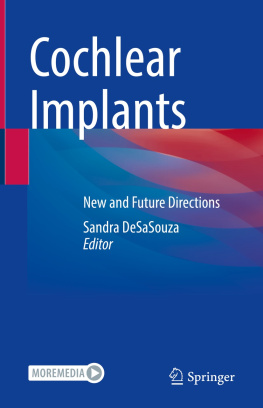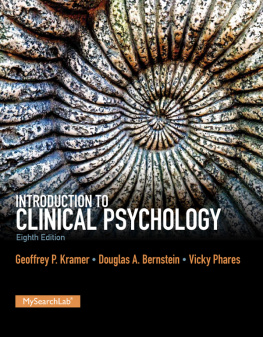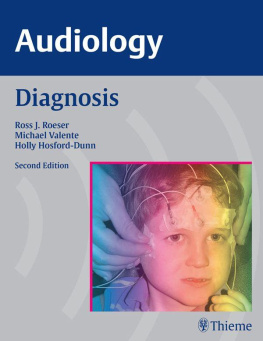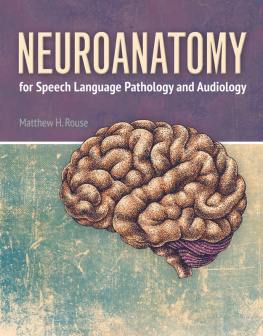Clinical Audiology
An Introduction
THIRD EDITION
Editor-in-Chief for Audiology
Brad A. Stach, PhD
Clinical Audiology
An Introduction
THIRD EDITION
Brad A. Stach, PhD
Virginia Ramachandran, AuD, PhD


5521 Ruffin Road
San Diego, CA 92123
e-mail:
Web site: https://www.pluralpublishing.com
Copyright 2022 by Plural Publishing, Inc.
Typeset in 11/13.5 Photina MT Std by Achorn International
Printed in the United States of America by McNaughton & Gunn, Inc.
All rights, including that of translation, reserved. No part of this publication may be reproduced, stored in a retrieval system, or transmitted in any form or by any means, electronic, mechanical, recording, or otherwise, including photocopying, recording, taping, Web distribution, or information storage and retrieval systems without the prior written consent of the publisher.
For permission to use material from this text, contact us by
Telephone: (866) 758-7251
Fax: (888) 758-7255
e-mail:
Every attempt has been made to contact the copyright holders for material originally printed in another source. If any have been inadvertently overlooked, the publisher will gladly make the necessary arrangements at the first opportunity.
Disclaimer: Please note that ancillary content (such as documents, audio, and video, etc.) may not be included as published in the original print version of this book.
Library of Congress Cataloging-in-Publication Data
Names: Stach, Brad A., author. | Ramachandran, Virginia, author.
Title: Clinical audiology : an introduction / Brad A. Stach, Virginia Ramachandran.
Description: Third edition. | San Diego, CA : Plural Publishing, [2022] | Includes bibliographical references and index.
Identifiers: LCCN 2020040050 | ISBN 9781944883713 (hardcover) | ISBN 1944883665 (hardcover) | ISBN 9781944883720 (ebook)
Subjects: MESH: Hearing Disorderstherapy | Audiology | Hearing Tests
Classification: LCC RF290 | NLM WV 270 | DDC 617.8dc23
LC record available at https://lccn.loc.gov/2020040050
Contents
Kathryn F. Makowiec and Kaylee J. Smith
THIS introductory textbook provides an overview of the broad field of audiology, a clinical profession devoted to the diagnosis and treatment of hearing and balance disorders. The aim of this book is to provide general familiarization with the many different assessment and treatment technologies and to demonstrate how these technologies are integrated into answering the many challenging clinical questions facing an audiologist.
It is the intention of this book to introduce audiology as a clinical profession, to introduce the clinical questions and challenges that an audiologist faces, and to provide an overview of the various technologies that the audiologist can bring to bear on these questions and challenges. It is hoped that this type of approach will be of benefit to all students who might take an introductory course. This book will provide an understanding of the nature of hearing impairment, the challenges in its assessment and treatment, and an appreciation of the existing and emerging technologies related to hearing. For those who will be pursuing the profession of audiology, this book will also provide a basis for more advanced classes in each of the various areas, with the added advantage of a clinical perspective on why and how such information fits into the overall scheme of their professional challenge.
Rather than writing another introductory textbook focused on rudimentary details, we have attempted in this book to provide a big picture of the field of audiology. Our assumptions were that (1) the basics of hearing and speech sciences are covered in other textbooks and in other classes; (2) teaching a basic skill in any one aspect of audiometry is not as useful as a broader perspective; (3) each of the topic areas in this book will be covered in significant depth in advanced classes; and (4) by introducing new students to the broad scope of the field, they will be better prepared to understand the relevance of what they learn later. For the nonaudiology major, this will promote an understanding of the clinical usefulness of audiology, without undue attention to the details of implementation.
In some of the clinical areas, we have included clinical notes that give descriptions of particular techniques that the student might consider using. Knowing that there are as many ways to establish a speech threshold as there are people teaching the technique, for example, we were reluctant to burden the beginning student with arguments about the merits of the various methods. Rather, we used the notes to express an opinion about clinical strategies that we have used successfully. We would expect that the contrary opinions of a professor would serve as an excellent teaching opportunity.
This book is intended primarily for beginning-level students in the fields of audiology and speech-language pathology. It is intended for the first major course in audiology, whether it be at the undergraduate or graduate level. Both intentions challenged the depth and scope of the content, and we can only hope that we reached an appropriate balance.
Over 20 years have passed since the first edition of this textbook. We are excited and inspired by the progress made in hearing health care over those years. When the book was first written, the profession of audiology was just beginning its transition to the doctoral level. Newborn hearing screening had not yet been fully implemented, and we did not yet have clear insight into the diagnosis of auditory neuropathy, third-window disorders, and similar conditions. All of that has changed. Advances on the treatment side have been even more stunning, from the dramatic changes in hearing aid technology and connectivity to the remarkable impact of early cochlear implantation. Although the questions an audiologist faces have not really changed much over the years, the ability to address those questions has changed substantially. We hope that the third edition conveys this progress effectively.
NEW TO THE THIRD EDITION
Additional content includes
new case studies and enhanced perspectives on avoiding clinical errors;
new chapters on implants and hearing assistive technologies;
expanded content on many topics, including the latest advances in hearing aid and implant technologies; and
new chapter on the assessment of the vestibular system and balance function.
Kathryn F. Makowiec, AuD
Senior Staff Audiologist
Division of Audiology, Department of Otolaryngology
Henry Ford Hospital
Detroit, Michigan
Kaylee J. Smith, AuD
Senior Staff Audiologist
Division of Audiology, Department of Otolaryngology
Henry Ford Hospital
Detroit, Michigan
THE historical perspective in is based on that of Dr. James Jerger. As the mentor of the first author, his influence permeates this book.
We have worked with a number of remarkably talented clinicians, clinical supervisors, professors, and colleagues in our careers. Each has contributed in some way to the knowledge base necessary to write a textbook of this breadth. We are grateful to all of them.









